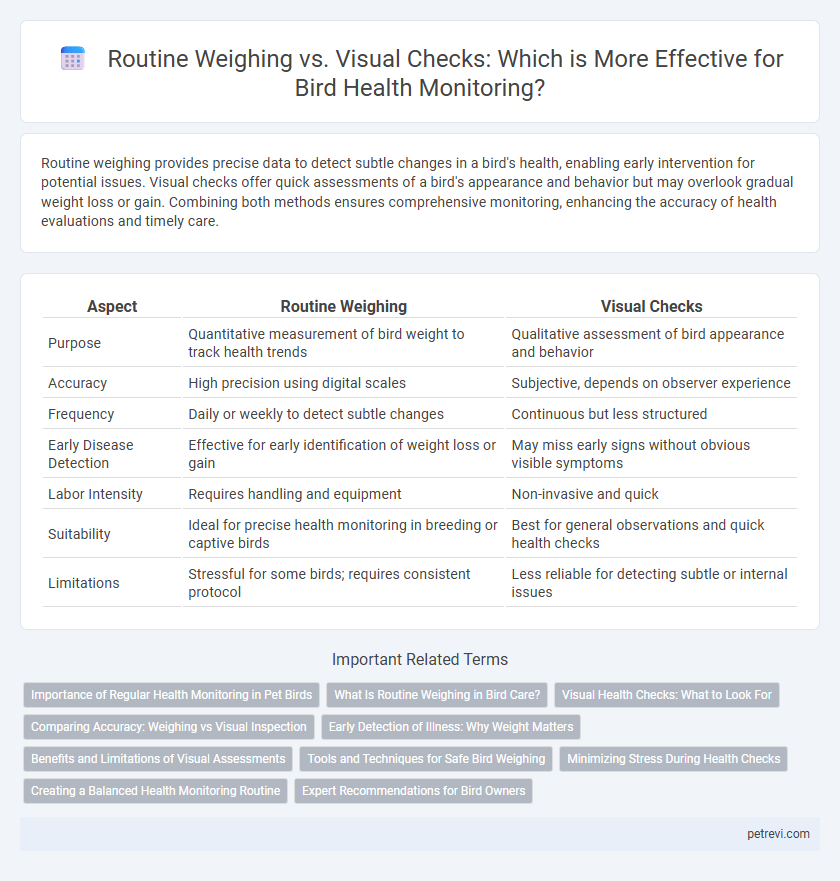Routine weighing provides precise data to detect subtle changes in a bird's health, enabling early intervention for potential issues. Visual checks offer quick assessments of a bird's appearance and behavior but may overlook gradual weight loss or gain. Combining both methods ensures comprehensive monitoring, enhancing the accuracy of health evaluations and timely care.
Table of Comparison
| Aspect | Routine Weighing | Visual Checks |
|---|---|---|
| Purpose | Quantitative measurement of bird weight to track health trends | Qualitative assessment of bird appearance and behavior |
| Accuracy | High precision using digital scales | Subjective, depends on observer experience |
| Frequency | Daily or weekly to detect subtle changes | Continuous but less structured |
| Early Disease Detection | Effective for early identification of weight loss or gain | May miss early signs without obvious visible symptoms |
| Labor Intensity | Requires handling and equipment | Non-invasive and quick |
| Suitability | Ideal for precise health monitoring in breeding or captive birds | Best for general observations and quick health checks |
| Limitations | Stressful for some birds; requires consistent protocol | Less reliable for detecting subtle or internal issues |
Importance of Regular Health Monitoring in Pet Birds
Regular health monitoring in pet birds is crucial for early detection of illnesses and prevention of serious conditions. Routine weighing provides objective data to track subtle weight changes that may indicate health issues before visible symptoms appear. Visual checks complement weight measurements by identifying behavioral and physical abnormalities, ensuring comprehensive assessment of a bird's well-being.
What Is Routine Weighing in Bird Care?
Routine weighing in bird care involves regularly measuring a bird's weight using precise scales to detect subtle changes that may indicate health issues early. This method provides quantitative data that helps caregivers monitor trends and adjust diets or treatments before visible symptoms appear. Accurate, consistent weighing is critical for preventing illness and ensuring optimal bird health.
Visual Health Checks: What to Look For
Visual health checks for birds involve observing feather condition, alertness, and respiratory rate to detect early signs of illness. Key indicators include ruffled feathers, discharge from the eyes or nostrils, and changes in posture or behavior. Regular visual monitoring enables timely intervention and supports overall avian well-being without the stress of frequent handling.
Comparing Accuracy: Weighing vs Visual Inspection
Routine weighing of birds provides precise, quantitative data that can detect subtle changes in body mass indicative of health issues, outperforming visual checks in accuracy. Visual inspections rely on observable signs such as feather condition and posture, which may miss early or minor fluctuations in weight-related health status. Implementing regular weighing as part of bird health monitoring offers a more reliable and objective method to identify health concerns promptly.
Early Detection of Illness: Why Weight Matters
Routine weighing of birds offers precise data on subtle weight fluctuations that visual checks can overlook, enabling early detection of illness before symptoms become visible. Weight loss often precedes behavioral changes or physical signs, making regular measurement a critical component in monitoring avian health. Combining routine weighing with visual assessments significantly enhances the accuracy and timeliness of disease diagnosis in birds.
Benefits and Limitations of Visual Assessments
Visual checks for bird health monitoring offer quick, non-invasive insights into plumage condition, posture, and activity levels, facilitating early detection of visible signs of illness or distress. However, visual assessments rely heavily on observer experience and may miss subtle weight fluctuations or internal health issues, limiting their accuracy compared to routine weighing. Integrating visual evaluations with regular weighing provides a more comprehensive approach, balancing ease of monitoring with precise biometric data.
Tools and Techniques for Safe Bird Weighing
Routine weighing of birds using precision digital scales provides accurate data crucial for monitoring subtle weight changes that indicate health issues, outperforming subjective visual checks. Employing secure weighing platforms with non-slip surfaces and minimal stress techniques ensures safe handling, reducing the risk of injury and behavioral distress. Integrating automated weighing systems with data logging capabilities enhances consistency and facilitates timely health interventions.
Minimizing Stress During Health Checks
Routine weighing of birds provides precise health data by tracking weight fluctuations critical for early illness detection, while visual checks allow for quick assessment without physical handling. Minimizing stress during health checks is essential; gentle handling techniques and using familiar environments can reduce anxiety in birds, promoting more accurate health monitoring. Combining both methods ensures comprehensive care while prioritizing the bird's emotional well-being.
Creating a Balanced Health Monitoring Routine
Routine weighing provides precise data on a bird's health by tracking weight fluctuations that could indicate illness or nutritional issues, while visual checks allow for immediate assessment of feather condition, behavior, and alertness. Incorporating both methods ensures early detection of subtle health changes and supports comprehensive monitoring. Establishing a balanced routine with scheduled weigh-ins complemented by daily visual inspections optimizes bird well-being and promotes timely intervention.
Expert Recommendations for Bird Owners
Experts recommend routine weighing as a precise method for monitoring bird health, enabling early detection of weight loss linked to illness. Visual checks complement weighing by assessing feather condition, posture, and behavior, providing a holistic view of the bird's well-being. Combining regular weight measurements with detailed observations ensures timely interventions and improved health outcomes for pet birds.
Routine Weighing vs Visual Checks for Bird Health Monitoring Infographic

 petrevi.com
petrevi.com